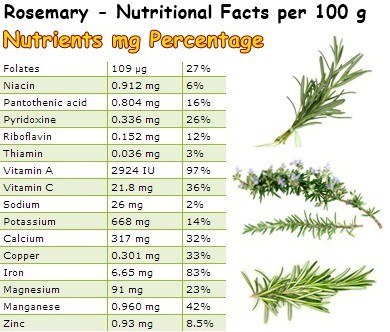Healthy and fragrant, rosemary (Rosmarinus officinalis) is a popular Mediterranean herb and culinary spice. Although its leaves and branches are used principally for flavoring food, the herb boasts significant nutritional value and is a good source of vitamins B6, A and C, iron, calcium, manganese and magnesium, promoting the health of the digestive, cardiovascular and immune system, as well as muscle and bone health, granted, it’s best consumed in limited amounts.
A single branch of rosemary is just as nutritious as a medium-sized apple. Believe it or not, regular consumption supports healthy eyes and mucous membranes, helps prevent tiredness and low energy levels as a result of anemia, promotes muscle tone and offers significant antioxidant protection to cells. Best of all, rosemary has such a pleasant flavor that it makes ordinary dishes simply stand out.

What is rosemary?
Rosemary plants are perennial shrubs, meaning you plant them and they grow year after year until they reach about 1-2 meters in height. Regardless of the variety, the shrub loves warm, Mediterranean climates but adapts well to more temperate climates as well. Gardening tip: if you want your rosemary to thrive, plant it in a sunny place and drained, loamy soil. Depending on the variety, the flowers may vary in color from white, pink and lavender to deep blue and purple, the last two being the most common.
Rosemary uses, benefits and side effects
Seeing it is both nutritious and beautiful, it has become a favorite ornamental plant among passionate gardeners and cooks alike.
Rosemary owes its popularity as a culinary spice to its unique, piney fragrance, a result of a combination of natural flavor-giving chemical compounds with powerful anti-inflammatory, antioxidant and antitumor properties. For example, the flowers contain a potent anti-inflammatory and antioxidant phenol called rosmarinic acid, also found in other aromatic herbs such as basil, sage, thyme, peppermint and lemon balm. See the herbs and spices page.
Other chemical compounds that contribute to the unique flavor of rosemary are cineol, camphene, borneol, bornyl acetate, phytochemicals with potent anti-inflammatory, antiseptic, antifungal and antiallergenic activity. But remember: spices should all be consumed in small amounts (a few branches of rosemary to give flavor to your roast pork, for example). Eating too much rosemary or other spices (excessive amounts) will lead to a too high a intake of volatile aromatic compounds to accumulate in the body and cause serious side effects.

If you take a look at the nutrition table below, you will see that rosemary is an above-average spice from the point of view of its nutritional value. It’s cholesterol-free and a good source of dietary fiber, although considering the amounts it is consumed in, it may not have a significant contribution to lowering blood cholesterol levels or relieving constipation.
Rosemary is a good source of B vitamins, notably folate, pantothenic acid, pyridoxine and riboflavin. B vitamins are vital for digestive health and support nervous system activity. Even when consumed in trace amounts, the herb adds to our intake of B vitamins, contributing to good health.
Rosemary is especially rich in vitamin A: 97% of the RDA. Vitamin A maintains healthy mucous membranes in the eyes, nose, throat, lungs and digestive tract, contributing to good immunity and protects the retina thanks to its powerful antioxidant effects, shielding the eye from harmful radiation from light.

The fresh leaves boast a good vitamin C content. Eating foods rich in vitamin C supports blood vessel, skin and bone integrity and delays aging signs such as loose skin and wrinkles. However, the dried or cooked herb is more likely devoid of vitamin C because the nutrient is highly sensitive to heat and both drying and cooking employ heat.
Rosemary owes its antioxidant properties to vitamins A and C, as well as manganese, three essential nutrients that offer protection against free radical damage. By protecting cells and DNA from oxidative stress, antioxidants are believed to lower our risks of developing chronic, degenerative diseases such as cancer, cardiovascular disease or neurodegenerative illnesses.
Last but not least, the herb is a pretty good source of iron (83%), copper (33%), calcium (32%), magnesium (23%) and potassium (14%). Regular consumption helps prevent mineral deficiencies and promotes cardiovascular, bone and immune system health. For more information on vitamins, minerals and the best food sources of any of these essential nutrients, see the vitamins and minerals page in the menu above.
How to use rosemary
Rosemary is great for a variety of dishes but pairs best with roast chicken, pork, lamb or beef. You can always put a few rosemary branches in your olive oil to give it extra flavor or use them to marinade your meat. A classic recipe is rosemary and garlic baked potatoes, but you can always turn the branches into skewers and give an awesome twist to your barbecues or add them to lemonade.
Nevertheless, because they are hard and needle-like, rosemary leaves can be a bit too difficult to swallow. Some people say that they feel like chocking on small fish bones when trying to swallow them. If a family member or a friend is experiencing difficulty with this, you can always use dried, ground rosemary or mash the fresh leaves yourself with a pestle before incorporating into food. And remember: a single branch of fresh rosemary is just as nutritious as a medium-sized apple.
